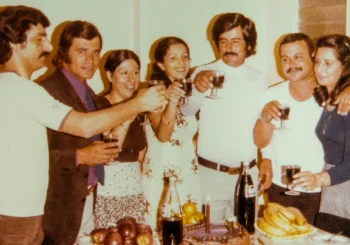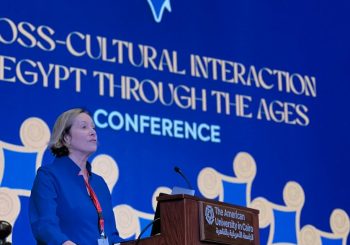Could it be that the simple joys of our time, like watching the sky in the early morning, might become completely alien in the future? Could a simple walk outside, at any hour of the day, eventually seem strange or unusual? And is it possible that what once felt natural, could become unfamiliar and unnatural?
These questions are explored in Azza Sultan’s fascinating short story, The Sky Room (translated by Raphael Cohen), included in the anthology, Egypt +100: Stories from a Century after Tahrir (2024), published by Comma Press. The collection presents a series of science fiction tales that envision life in Egypt a hundred years from now, blending the boundaries between reality and fiction.
The story is told through a series of conversations between a daughter and her father, interlaced with her memories of their past discussions about nature. In a world where even casual outings are heavily regulated and artificial technology dominates, she clings to the stories of her father’s love for the natural world — the artistic patterns of the clouds, the hues of the sea, and the simple pleasure of walking barefoot on the ground.
Time and time again, her nostalgic memories of her father remain as the sole tether to her humanity, a stark contrast to the emotionless world that surrounds her.
An artificial world
Set in a future dominated by artificial intelligence and technology, the story envisions a world where even the skies are artificially controlled, with humans able to alter their colors and shapes. What was once a simple view from a window, balcony, or mountaintop has transformed into an artificial playground where people manipulate the sky’s appearance.
In Sultan’s story, the sky is discussed during a conversation between a father and his daughter. The father describes clouds as secret messages from the earth to the sky, creating an imaginative tale to help his daughter better grasp and understand the real sky, since she has mostly seen artificial skies throughout her life.
The sky’s loss of its natural essence acts as a metaphor for the short story collection as a whole, reflecting how nature becomes a historical artifact or monument, akin to the pyramids—relics of a past era experienced only by ancient societies.
Just as older generations associate printed newspapers or rotary dial telephones with a bygone era, nature too becomes a part of history in this work of fiction. Its true essence can only be experienced and appreciated through the stories shared by those who have lived among it. It is through these stories that future generations protect, cherish, and honor nature.
This metaphor also ties into a significant theme in the collection: the effects of climate change.
Michel Hanna’s short story, Encounter with the White Rabbit (translated by Mohammed Ghalayini), examines how climate change transforms Egypt’s future, resulting in submerged cities and massive migrations, a scenario not unlike the current concerns over rising sea levels in Alexandria. This environmental crisis creates a sharp contrast between cities that are protected from climate change and those devastated by it, underscoring the growing divide between different societies.
Cairo transforms into a place unfamiliar and forgotten by its inhabitants, with even Cairo International Airport left in ruin. The city has become a disordered refuge for those fleeing the effects of climate change on other cities. What once defined Cairo now exists only as a distant memory in the hearts of its citizens, and through the stories of older generations.
Although science fiction may appear entirely imaginative, it often mirrors our present reality.
In Cairo, billboards and television ads frequently present a vision of a futuristic Egypt—one marked by clean streets, towering skyscrapers, and a sense of order. The term “New Republic” is commonly used by politicians to describe this envisioned future. However, while such a future can offer hope for progress, literature encourages us to look back and reflect more gently and deeply: what does it truly mean to be futuristic, and does a futuristic vision necessarily guarantee prosperity for everyone?
Cities haunted by the past
Cities can never truly escape their history or past identity, which is a recurring theme in many of the stories in the collection. Even as modernization reshapes everything, ordinary people continue to carry the echoes of past wars, revolutions, and sociopolitical movements.
Despite all the advancements and futuristic changes, human emotions remain constant and unchanged, as though nothing ever changed. People still yearn for love, compassion, and passion the same way they do now.
Some of these stories are not about the revolutions themselves, but about the revolutionaries—those who were inspired and transformed by ideas. The collection explores how revolutionary concepts can continue to influence individuals, not just entire nations. Even if history will never return, the ideas and passions of past leaders and revolutionaries continue to swim through time.
As historian James H. Billington once stated in his book, Fire in the Minds of Men (1980), the study of revolutions often emphasizes elite figures, while the experiences of working-class revolutionaries and ordinary people are frequently overlooked. This short story collection, in contrast, aims to address that gap by exploring how revolutionaries have come to embody a unique form of faith—both a deep-seated ideological commitment and a spirited adherence to revolutionary ideals.
History does not always remember ordinary people. While it records the tales of nations, leaders, monuments, and temples, the stories of everyday individuals who lived through these times tend to fade, lingering only in the memories of their loved ones who carry their legacy forward.
The book explores the idea that places are more than just physical locations; they are living, breathing entities that carry the weight of human memories and emotions. Even when they evolve, their spirit remains intact.
In the end, after time has erased much of what once was, it is the stories that keep us connected to our past. Through these stories, we come to understand that what we truly hold onto is not the land itself, but the spirit it represents.
The legacy of ordinary people, however small, lives on in the stories we share. Their smiles, words, and actions continue to inspire and move us. While they may not have had grand memorials, their legacy lives on in our hearts. And it is in our hearts that the true history of nations is written.








Comments (0)